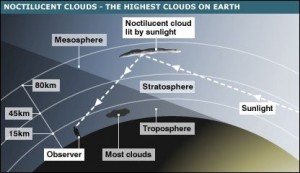Noctilucent Clouds, Methane & Climate Change
From an Article by Damond Benningfield, StarDate Today, July 26, 2015
If you live at high northern latitudes, you might see some eerie clouds at this time of year. They show up for a little while in deep twilight, and shine electric blue. And they appear to have a connection to both meteors and our planet’s changing climate.
Noctilucent clouds were first reported in 1885. That sighting may have been related to the eruption of Krakatoa, a powerful volcano in Indonesia. Tiny grains of ash from the explosion may have drifted to the top of the atmosphere — altitudes of 45 to 50 miles. Molecules of water then latched on to the ash particles, forming ice crystals.
But recent research suggests that most noctilucent clouds are seeded by tiny grains of space dust. These particles bombard our planet all the time. Many of them are so small that they don’t fall to the ground, but linger in the upper atmosphere. They form the kernels around which cloud particles grow.
Sightings of noctilucent clouds have become more common in recent years, and the clouds have been seen farther south than ever before — as far down as Utah and Colorado.
Research says that could be a result of the extra methane we release into the air every year. Some of the methane climbs to high altitudes. Sunlight triggers a series of reactions that breaks the methane apart, leaving two water molecules. That provides more water to freeze around the nuggets of space dust — creating more of these electric-blue clouds in the twilight.
@ For more skywatching tips, astronomy news, and much more, read StarDate magazine.
>>>>>>>>>>>>>
Excerpt on Noctilucent Clouds from Wikipedia.org
Most recently in 2012 Lonnie Cumberland’s physics PhD work supported viewing noctilucent clouds as a possible Miner’s Canary for climate change as her third conclusion as a sign of increasing the presence of water in the high atmosphere.[1] NASA scientists speculate that methane may be driven higher into the mesophere where noctilucent clouds form by climate change and through reactions end up producing water at such altitudes.[55]
Climate models predict that increased greenhouse gas emissions cause a cooling of the mesosphere, which would lead to more frequent and widespread occurrences of noctilucent clouds.[50] A competing theory is that larger methane emissions from intensive farming activities {and other sources} produce more water vapor in the upper atmosphere.[14] Methane concentrations have more than doubled in the past 100 years.[3]
See also: www.InsideClimateNews.org

